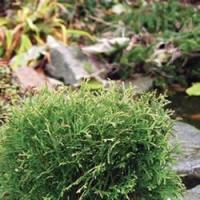Slow Growing Conifers
Make Great
Landscaping Trees
Conifers will need to be of the slow growing variety if you want low maintenance landscaping trees. They will need little attention after their first year, as long as they are given a good start with careful site preparation and planting
Dwarf and slow-growing conifers can be columnar, rounded, oval or prostrate in outline, and to look effective they are best grown as a group with contrasting shapes, sizes and colors. They are ideal for small beds or borders where they will soon provide year round interest.
Planting Conifers...
If you find it difficult to plan beds and borders on paper, stand the pots where you think the plants will look good and be prepared to shuffle them around until they look right. Bear in mind the eventual height and spread.
Dig a hole larger and deeper than the rootball, and fork in rotted manure, garden compost or planting mixture, especially on dry soils, and then work in a controlled or slow-release fertilizer. Finally, mulch with a decorative material at least 5cm (2 inches) thick.
Heather And Conifer Beds...
Dwarf conifers combine especially well with heathers, their foliage provide fascinating contrasts of texture and color. There are hundreds of suitable heathers and conifers so you can design exactly what you want.
Remember to choose varieties that are suitable for your soil type. The initial outlay may seem expensive, but the bed should last for a long time without the need for replanting and will require minimal maintenance.
Planting A Mixed Bed...
Arrange and plant all the conifers first, making sure they look pleasing from all angles. Space the heathers around the conifers, and then plant them in groups or drifts of one variety at a time.
Avoid planting the heathers too close to the conifers as all the plants will spread and merge into each other within a year or two. Meanwhile cover the bare soil with chipped bark or gravel.
Arborvitae - Little Giant Dwarf Conifer...

Thuja occidentalis 'Little Giant', is slow-growing and spherical with rich green leaves. In general, this conifer is a tall columnar to conical; an evergreen tree with fissured, reddish bark. Its scale-like leaves are ovate, mid to dark-green on top, lighter beneath.
Females bear small cones with a small terminal hook on each scale. With its rich green soft textured foliage, Little Giant becomes a very useful shrub in the garden landscape; used for specimen, foundation plantings, and low borders.
This conifer is tolerant of wet soils and coastal conditions, very little pruning is required to maintain shape. Little Giant is an extremely hardy dwarf globe evergreen. It is easily grown in average, medium, well-drained soils in full sun to partial shade. Somewhat wide range of soil tolerance, but prefers moist, well-drained loams.
With a mature height and spread of approximately 3-4 feet it prefers full sun, but generally appreciates some light afternoon shade in hot summer climate.
Gardening Tools › Garden Landscaping › Landscaping Trees








New! Comments
Have your say about what you just read! Leave me a comment in the box below.